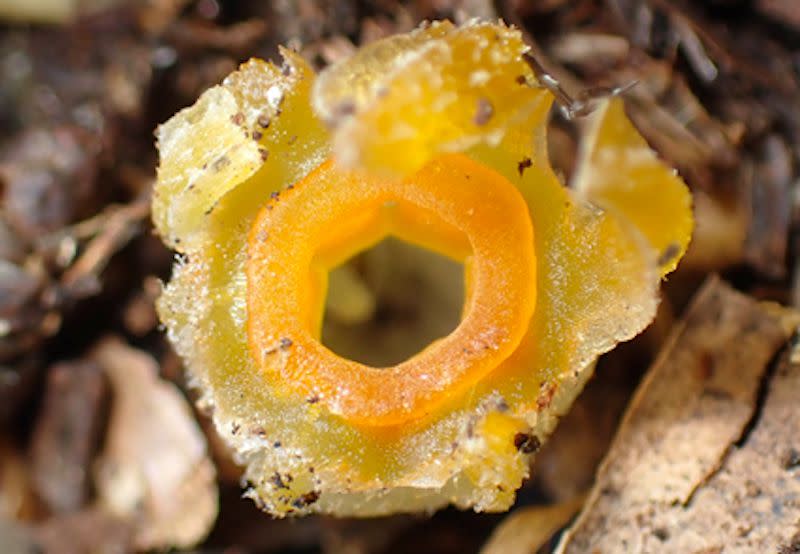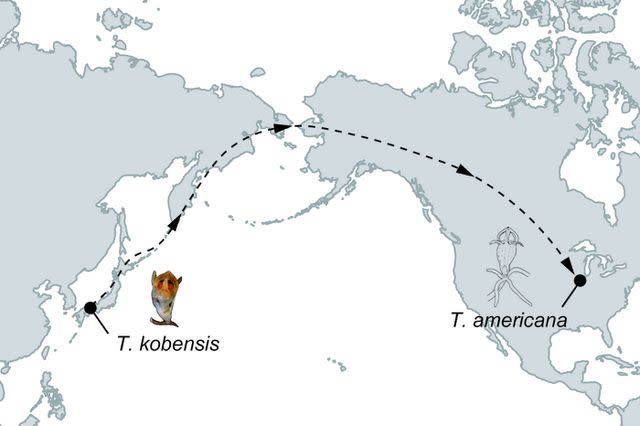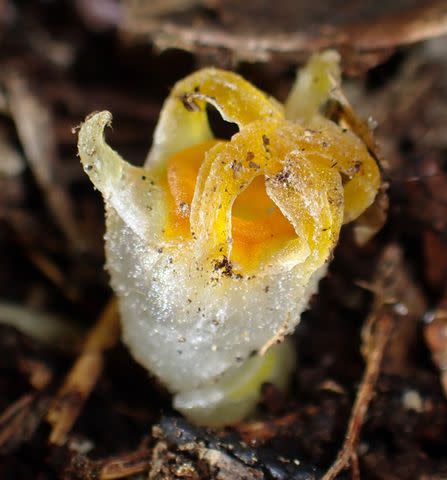Strange, Ethereal 'Fairy Lantern' Presumed Extinct is Rediscovered After 30 Years
The rediscovery adds insight into these odd plants and could provide motivation to protect their forest habitats.

Kenji Suetsugu.
As the moniker fairy lantern denotes, it looks like a tiny lantern that illuminates the dark forest floorLooking like the lovechild of an alien life form and a gumdrop, the genus Thismia (commonly known as fairy lanterns) is one of the plant world’s stranger creations. While most plants are characterized by green leaves and photosynthesis, Thismia has neither. Members of the genus are mycoheterotrophic monocot plants that depend on fungi for nutrition and the trees that sustain those fungi. Growing underground with their luminous flowers beaconing through the soil, around 90 species of Thismia have been discovered. But so unique are the plant’s requirements that many of those are only known from their original discovery location, and sometimes just from a single individual plant.
Such was the case with Thismia kobensis. A lone specimen was originally discovered in Kobe City, Japan, in 1992. As is all too often the case, its habitat was destroyed, in this instance, by the construction of an industrial complex. Despite scientists searching for another specimen for dozens of years, it was never seen again and was presumed extinct.
But now, after more than 30 years, Professor Kenji Suetsugu and his colleagues at Kobe University report its rediscovery in Sanda City, a little less than 20 miles away from the original discovery.
Refinding a member of such a rare and endangered genus is incredibly exciting, and subsequent investigations into T. kobensis have shed new light on the genus and its evolutionary history.
New Insight on a North American Fairy Lantern
Among the mysteries of Thismia, one species, Thismia americana, has a puzzling distribution pattern that has long perplexed botanists—but the new discovery appears to reveal some clues.
T. americana, the only known North American fairy lantern species, was discovered over 100 years ago in a prairie near Chicago. Observed for just a few years and now considered extinct, botanists originally thought it was most closely related to species in Australia and New Zealand.
But a detailed morphological investigation suggested that the rediscovered T. kobensis is actually the closest relative of T. americana. The authors note that “the similarity in outer floral morphology between Thismia americana and the Australia-New Zealand species may have evolved independently based on pollinator preferences. This suggests that Thismia americana may actually be unrelated to the Australia-New Zealand species.”

Kenji Suetsugu
The proposed range expansion mechanism of fairy lanterns in the present studyFrom the study: “Plant species in Eastern Asia and North America having close relationships and disjunct distributions across these regions is not uncommon and can often be attributed to migration through the Beringia land bridge. Therefore, the disjunct distribution of Thismia americana may be due to migration through Beringia.”
Saving the Fairy Lanterns
The rediscovery of T. kobensis after three decades has significantly advanced researchers' understanding of fairy lanterns and provides crucial insight into the biogeography and evolutionary history of fairy lanterns as a whole.
But its discovery could also play a role in conservation efforts as well.

Kenji Suetsugu
Thismia kobensis in the forest floorAs the planet’s living things are on the brink of a sixth mass extinction—and every other day, it seems like we are hearing of another species now gone—the rediscovery of such a rare and fragile (and strange and beautiful!) plant provides a glimmer of something other than despair. For scientists, the find offers potential fodder for pursuing new conservation efforts.
“Although Thismia species plants are tiny and inconspicuous, they have been described as one of the most curious and extraordinary genera in the plant kingdom, and their odd appearance and life strategy make them exceptional among herbs,” write the study authors in their conclusion.
They explain that the forest environs of T. kobensis are almost entirely “disturbed” by logging but that the discovery might provide a push for local initiatives to obtain official protection for these forests, as has happened with other Thismia species. “Owing to its bright orange coloration,” note the authors, “T. kobensis could become a particularly iconic species in Japan.”
We usually lean on charismatic fauna like owls and giant pandas to push for habitat protection. But now, could a glowing and ethereal oddball of a plant become a poster child for habitat protection?
The study, "Rediscovery of the presumably extinct fairy lantern Thismia kobensis (Thismiaceae) in Hyogo Prefecture, Japan, with discussions on its taxonomy, evolutionary history, and conservation" was published in the journal, Phytotaxa.

